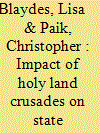| Srl | Item |
| 1 |
ID:
155494


|
|
|
|
|
| Summary/Abstract |
On the eve of the Meiji Restoration in 1868, the nearly 300 semi-autonomous domains across Japan had widely varying tax rates. Some handed over 70 percent of their rice yield to the samurai ruler of the domain, while others provided 15 percent. This variation existed in spite of the similar fiscal demands that the domain rulers faced within the Tokugawa regime—the feudal system that governed Japan between 1603 and 1868. This period was remarkably stable; Japan saw no foreign or domestic wars. This allows us to focus on the impact of pressure from below on taxation. We study the extent to which peasant-led rebellions and collective desertion (“flight”) lowered the subsequent tax rate imposed by samurai rulers. Using newly compiled data on different types of peasant-led political mobilization—from petitions to insurrections—we find an association between, on the one hand, large-scale rebellions and flight and, on the other, lower tax rates. We interpret the results as evidence of rebellious or mobile peasants’ ability to constrain their rulers; the more complacent fail to win concessions. Our findings suggest that peasant mobilization played a role in restricting state growth in early modern Japan through tax concessions.
|
|
|
|
|
|
|
|
|
|
|
|
|
|
|
|
| 2 |
ID:
131950


|
|
|
|
|
| Publication |
2014.
|
| Summary/Abstract |
In a novel approach to studying political mobilization among ethnic Tibetans in China, this article addresses two key questions. First, considering the Chinese state's repressive policies towards Tibetan Buddhism, what role does religion play in fomenting Tibetan political resistance? Second, what implications can be drawn from the changing ethnic demography in Tibet about the conflict behaviour of Tibetans? Using various GIS-referenced data, this article specifically examines the 2008 Tibetan protest movements in China. The main results of our analysis indicate that the spread and frequency of protests in ethnic Tibetan areas are significantly associated with the number of officially registered Tibetan Buddhist sites, as well as the historical dominance of particular types of Tibetan religious sects. Furthermore, our analysis shows that the effect of Han Chinese settlement on Tibetan political activism is more controversial than previously though
|
|
|
|
|
|
|
|
|
|
|
|
|
|
|
|
| 3 |
ID:
147550


|
|
|
|
|
| Summary/Abstract |
Holy Land Crusades were among the most significant forms of military mobilization to occur during the medieval period. Crusader mobilization had important implications for European state formation. We find that areas with large numbers of Holy Land crusaders witnessed increased political stability and institutional development as well as greater urbanization associated with rising trade and capital accumulation, even after taking into account underlying levels of religiosity and economic development. Our findings contribute to a scholarly debate regarding when the essential elements of the modern state first began to appear. Although our causal mechanisms—which focus on the importance of war preparation and urban capital accumulation—resemble those emphasized by previous research, we date the point of critical transition to statehood centuries earlier, in line with scholars who emphasize the medieval origins of the modern state. We also point to one avenue by which the rise of Muslim military and political power may have affected European institutional development.
|
|
|
|
|
|
|
|
|
|
|
|
|
|
|
|
| 4 |
ID:
165600


|
|
|
|
|
| Summary/Abstract |
This article investigates the role of colonial pressure on state centralization and its relationship to subsequent development by analyzing the influence of Western colonial threats on Siam’s internal political reform. Unlike other countries in the region, Siam remained independent by adopting geographical administrative boundaries and incorporating its traditional governance structures into a new, centralized governance system. The authors find that the order in which areas were integrated into the centralized system depended on the interaction between precentralization political structures and proximity to British and French territorial claims. The authors show that areas centralized early in the process had higher levels of infrastructure investment and public goods provision at the time the centralization process was completed in 1915 than those centralized later in the process. They also show that early centralization during the Western colonial era continued to be strongly associated with higher levels of public goods provision and economic development, and that this relationship persists today.
|
|
|
|
|
|
|
|
|
|
|
|
|
|
|
|